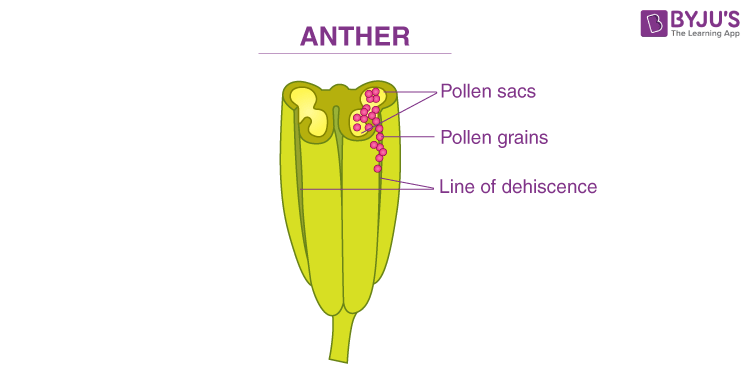The male reproductive part of the flowering plant has stamens. These stamens are filamentous structures that support the anther that produces the pollen grains. These anthers have two lobes and are termed bilobed anthers. The transverse section of the anther helps to distinguish this bilobed structure.
The two lobes of the anther are formed by a septum. Each lobe of a bilobed anther has two theca and two microsporangia. There are hundreds of microspores produced by each microsporangium. The anthers are lobbed so that they can accommodate more spores.
Structure of an Anther

- The filamentous stamen supports the knob-like anther on its top. A typical anther is always a bilobed and dithecous structure.
- Theca is a chamber on the anther lobes. Usually, each lobe has two theca and is hence named as dithecous.
- The transverse section of the anther shows two microsporangia in each lobe. Thus, they have four microsporangia in total.
- The microsporangia or the pollen sac consists of the pollen grains.
Extended Reading : Parts of a Flower
Frequently Asked Questions
What is a dithecous anther?
The anther lobes have chambers called theca. The lobes having two thecae are termed dithecous. Each theca has two pollen sacs or microsporangia. These microsporangia produce microspores that develop into pollen grains. Moreover, an anther need not be dithecous every time. Some can be monothecous with a single lobe or even polythecous with many lobes.
Example of dithecous anther – Solanum
Example of monothecous anther – Hibiscus (Malvaceae family).
What is a microsporangium?
A microsporangium is a circular structure covered by the epidermis. They produce microspores through meiosis. These microspores undergo mitotic division to become pollen grains. Thus, microsporangium helps in the development of pollen.
How many microsporangia are present in a bilobed anther?
Microsporangia or pollen sac aids in the development of pollen. Each anther lobe produces two pollen sacs, and thus four pollen sacs are produced in a bilobed anther. An anther having four pollen sacs or microsporangia is termed as a tetrasporangiate anther. A typical anther is always a tetrasporangiate structure.
Also Read: Embryo sac
Keep Exploring BYJU’S Biology for more interesting topics.
Comments